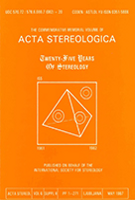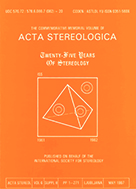- Home
- Volume 2 (1983)
- Number 2 - Proceedings of the second symposium on ...
- Diagnostic morphometry: aims, types, conditions and applications
View(s): 283 (1 ULiège)
Download(s): 68 (1 ULiège)
Diagnostic morphometry: aims, types, conditions and applications

Abstract
Two general types of quantitative pathology applications are available for routine use: image processing and flow-cytometry. This paper deals with a subset of image processing in which most of the diagnostic applications available today are found: diagnostic morphometry.
The aims of quantitative pathology are to eliminate the subjective nature of the usual cytological and histological evaluations, which imply a considerable degree of disagreement between pathologists. Secondly, the quantitative and continuous nature of morphometrical features allows the expression of the numerical classification probability. Automatic classifiers with digital image processing computers at the moment are not (yet) available and therefore, the pathologist has to select the diagnostically interesting cells and areas. Thus, it is a SELECTIVE approach, which together with multivariate analysis is an essential condition in the useful application of diagnostic morphometry today.
The applications so far available can be subdivided in three types: for quality control, to support or to decide for a certain diagnosis or grade, or to decide for a certain treatment. Obviously an increasing degree of reliability is required from the first to the third type. In addition, five levels of quality can be discerned in quantitative pathology studies. First level studies describe discriminating features (to distinguish two or more groups). A multivariate classification rule with numerical classification probabilities are the highest quality within this level. Level II studies confirm the results of level I studies in a test set, in the same laboratory. Level III studies confirm the results of level I studies in a test set, but now in another laboratory, on different material by independent investigators. Alternatively the same results may be found independently in several laboratories in independent studies. Level IV studies confirm level I findings, when routinely used in the same laboratory. Level V studies are similar to level IV studies, but now in different laboratories.
Most of the applications so far available are type 1 or 2, level I-III. A few applications are level IV and the number of level V applications is restricted. In contrast, level I-III studies are rapidly increasing.
Although further multicenter studies are essential, diagnostic morphometry applications so far available confirm the original expectations that this method is useful in diagnostic pathology. Several of the original aims already have seen reached. Further development, especially in the area of digital image processing is a promising future possibility.






